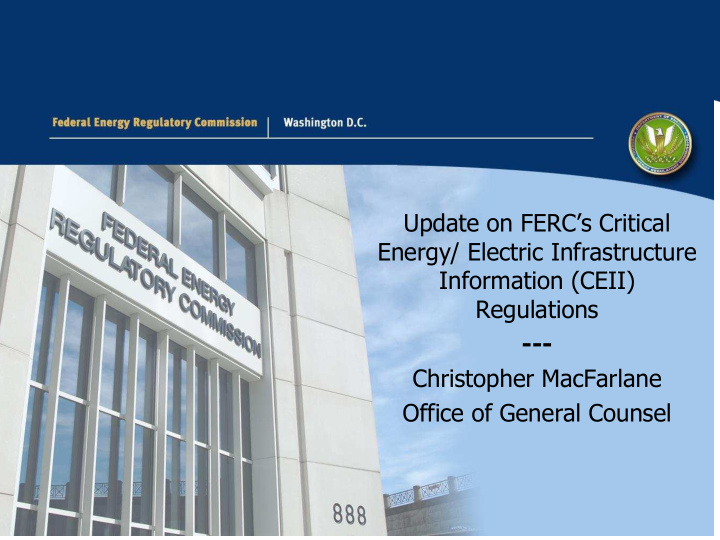



Update on FERC’s Critical Energy/ Electric Infrastructure Information (CEII) Regulations --- Christopher MacFarlane Office of General Counsel 1
Disclaimer The views expressed herein are mine, and do not necessarily reflect the views of the Commission, individual Commissioners, Commission staff, or individual Commission staff members. 2
Critical Energy Infrastructure Information Regulations • Shortly after September 11, 2001, the Commission took steps to protect information that it considered Critical Energy Infrastructure Information. • On February 21, 2003, FERC issued a final rule amending its regulations to establish a procedures for protecting and accessing Critical Energy Infrastructure Information. 3
Critical Energy Infrastructure Information • Critical Energy Infrastructure Information is defined, by Commission regulation, as specific engineering, vulnerability, or detailed design information about critical infrastructure that: (i) Relates details about the production, generation, transportation, transmission, or distribution of energy; (ii) Could be useful to a person in planning an attack on critical infrastructure; (iii) Is exempt from mandatory disclosure under the Freedom of Information Act, 5 U.S.C. 552; and (iv) Does not simply give the general location of the critical infrastructure. 06/06/2018 4
The FAST Act • On December 4, 2015, the President signed the Fixing America’s Surface Transportation (FAST) Act into law. The FAST Act added section 215A to the Federal Power Act (FPA) to improve the security and resilience of energy infrastructure in the face of emergencies. • FPA section 215A(d)(2) required the Commission to promulgate such regulations as necessary to: – Establish criteria and procedures to designate information as CEII; – Prohibit unauthorized disclosure of CEII; – Establish sanctions for employees and certain other individuals who knowingly and willfully make unauthorized disclosures; and – Facilitate voluntary sharing of CEII among federal, state, political subdivision and tribal authorities; the ERO; regional entities; owners, operators and users of critical electric infrastructure; and other entities deemed appropriate by the Commission. 5
Critical Electric Infrastructure Information • Section 215A(a)(3) of the FAST Act defines Critical Electric Infrastructure Information to mean: [I]nformation related to critical electric infrastructure, or proposed critical electrical infrastructure, generated by or provided to the Commission or other Federal agency other than classified national security information, that is designated as critical electric infrastructure information by the Commission or the Secretary of the Department of Energy pursuant to subsection (d). Such term includes information that qualifies as critical energy infrastructure information under the Commission’s regulations. • Pursuant to section 215A(d)(1) of the FPA: Critical Electric Infrastructure Information is: Exempt from mandatory disclosure under the Freedom of Information Act, 5 U.S.C. 552 and exempt from State Sunshine Laws. 6
Order No. 833 • On November 17, 2016, FERC issued Order No. 833, which amends its CEII Regulations to: – Implement the provisions of the FAST Act that pertain to the designation, protection and sharing of CEII; and – Integrate the existing Critical Energy Infrastructure Information program with the new requirements of the FAST Act. • The rule became effective on February 21, 2017. 7
Revised CEII Regulations • Designation of CEII- The regulations provided procedures for the public to request CEII treatment of a submission and for the designation of Commission generated documents. • Sharing of CEII – The Commission revised the process for the public to request access to CEII, clarified the process for sharing CEII with other agencies, and established procedures for voluntary sharing of CEII with certain entities. • Protection of CEII - The revised CEII regulations confirmed the duty to protect CEII, and created sanctions for personnel that knowingly and willfully disclose CEII in an unauthorized manner. 06/06/2018 8
Rehearing of Order 833 • Rehearing Request – Edison Electric Institute asserted that the Commission either erred or should reconsider five aspects of Order No. 833 • Order 833-A - The Commission denied rehearing, but clarified, in part, certain aspects of the CEII rules related to the criteria for responding to CEII requests, the designation of FERC generated CEII, and FERC’s non -disclosure agreement. 06/06/2018 9
CEII & Other Agencies • Department of Energy (DOE) - FAST Act specifically authorizes FERC and the DOE to designate information as CEII. • Other Federal agencies - In Order 833, the Commission recognized that other Federal agencies may possess critical energy infrastructure information. As such, section 388.113(a), states that: Nothing in this section limits the ability of any other Federal agency to take all necessary steps to protect information within its custody or control that is necessary to ensure the safety and security of the electric grid. To the extent necessary, such agency may consult with the CEII Coordinator regarding the treatment or designation of such information. • Federal Agency Request Process - FERC staff also revised the procedures for processing Federal agency requests for CEII. 10
CEII & State Agencies • State Agencies – The FAST Act provides that CEII: – “shall not be made available by any Federal, State, political subdivision or tribal authority pursuant to any Federal, State, political subdivision or tribal law requiring public disclosure of information or records.” 06/06/2018 11
Recommend
More recommend